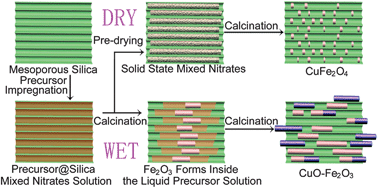Who said a complex problem demands a complex solution? A recent article by Li et al. has shown that this could not be further from the truth. This team at the University of Hangzhou have taken a relatively simple approach to remedy the more complex problems of phase separation and poor reproducibility that are associated with the synthesis of bimetal oxide nanoparticles supported on mesoporous silica.
These materials, that combine just the right amounts of nano-activity with the benefit of macro-sized supports for easier handling, show great potential in the field of catalysis however difficulties in their preparation is creating limitations. As this paper demonstrates, the addition of a facile pre-drying treatment inserted into the material preparation process is the key to avoiding problems. The work mainly focuses on applying this technique to the synthesis of CuFe2O4 catalysts, but also tests the same procedure on NiFe2O4, CuCr2O4 and CoFe2O4 with great success. Catalytic activity of the synthesised CuFe2O4 was tested using the enantioselective reduction of acetophenone at room temperature, resulting in a yield of 93% and 93% ee. The magnetic properties of the catalyst, due to the presence of Fe, lead to easy recovery from the reaction and subsequent reuse showed retention of activity and enantioselectivity.
A facile strategy for the preparation of well-dispersed bimetal oxide CuFe2O4 nanoparticles supported on mesoporous silica
Bin Li, Min Li, Chaohua Yao, Yifeng Shi, Danru Ye, Jing Wu and Dongyuan Zhao
J. Mater. Chem. A, 2013, 1, 6742-6749. C3TA10506G
H. L. Parker is a guest web writer for the Journal of Materials Chemistry blog. She currently works at the Green Chemistry Centre of Excellence, the University of York.
To keep up-to-date with all the latest research, sign-up to our RSS feed or Table of contents alert.











